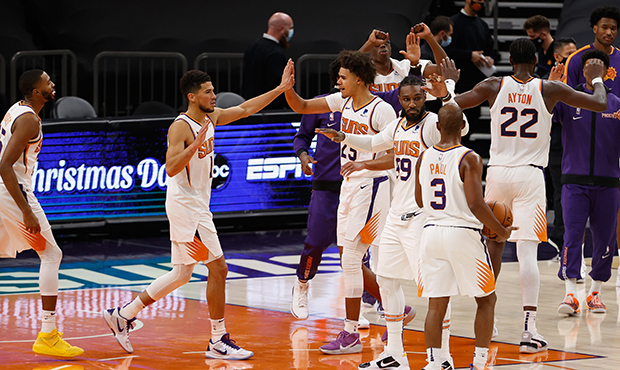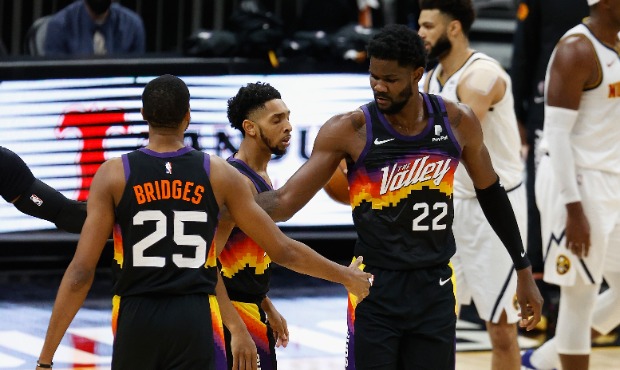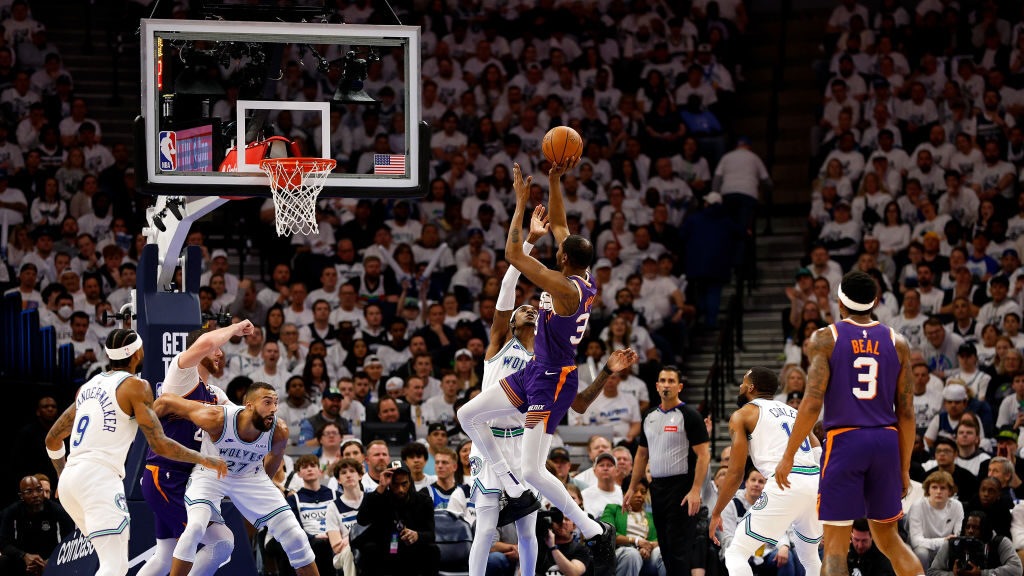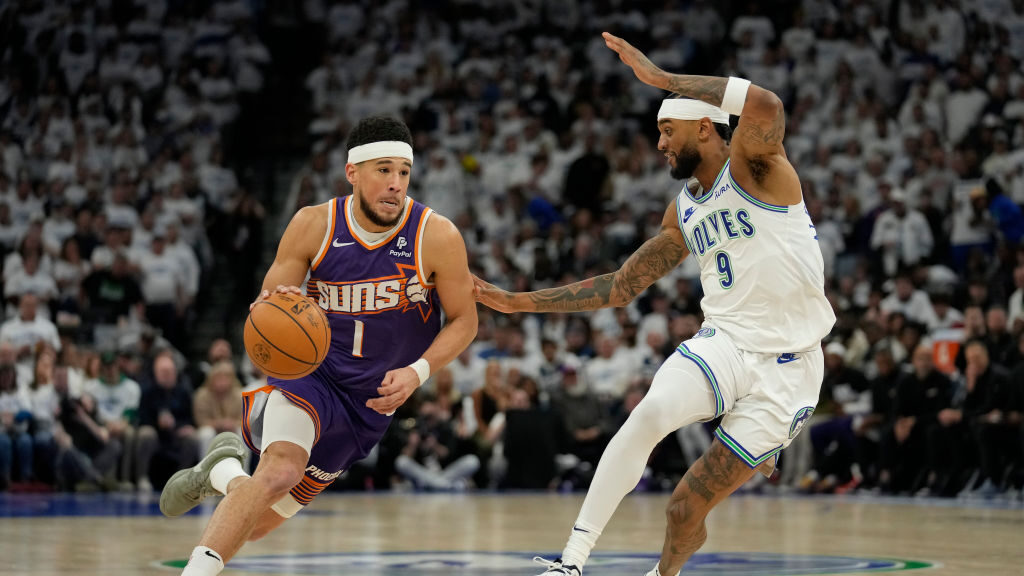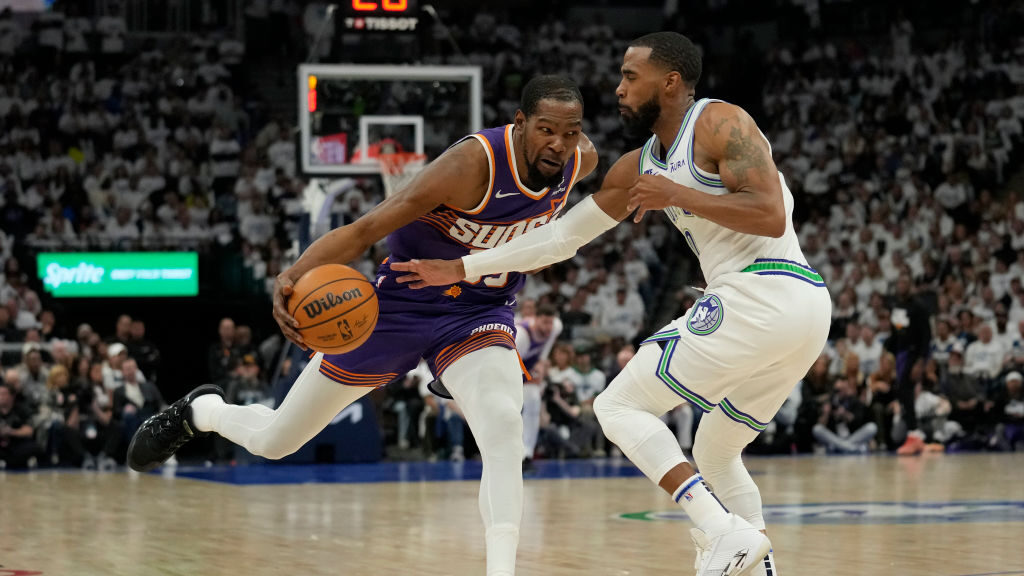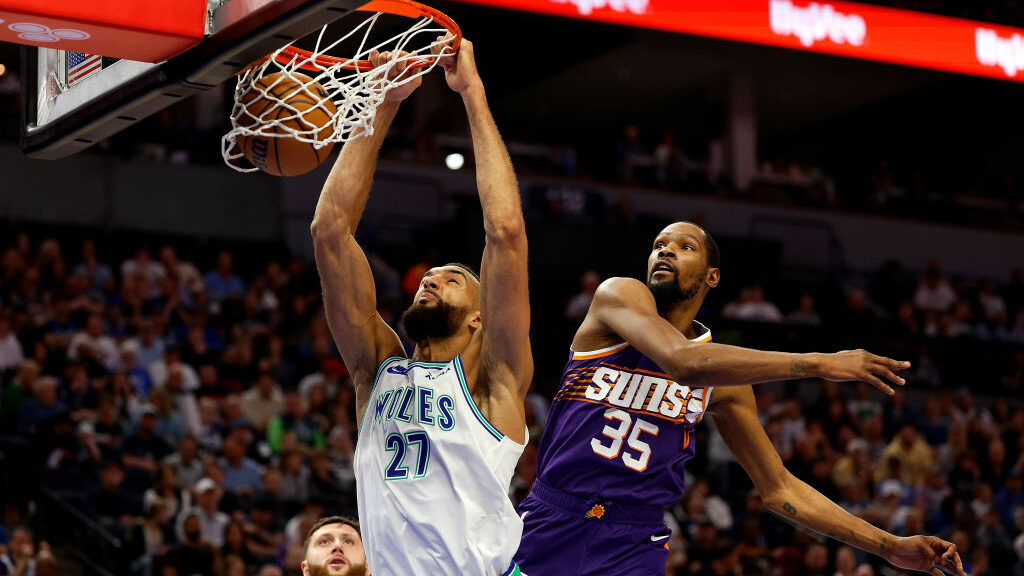Offseason, long-term questions loom over Suns’ return to playoffs
May 17, 2021, 12:31 PM | Updated: 2:17 pm

Devin Booker #1 of the Phoenix Suns talks with Deandre Ayton #22 and Mikal Bridges #25 during the NBA game against the Oklahoma City Thunder at Phoenix Suns Arena on April 02, 2021 in Phoenix, Arizona. The Suns defeated the Thunder 140-103. (Photo by Christian Petersen/Getty Images)
(Photo by Christian Petersen/Getty Images)
The Phoenix Suns have the biggest gap between their floor and ceiling of any playoff team.
As a young and inexperienced team, especially in the postseason, a first-round exit would be surprising, but shouldn’t be completely ruled out. The draw of either the Los Angeles Lakers or Golden State Warriors in the first round doesn’t help matters.
The Suns are also more talented than just about any team in the Western Conference with the combination of a great defense and two complete offensive players who could take them all the way.
It’s worth bringing up — and particularly fascinating — because of what the Suns have spent the course of this season figuring out before decisions will have to be made this offseason.
Paul’s player option
The Chris Paul era in Phoenix has been a rousing success. He’s been worth every bit of a $41.2 million salary (that’s quite the statement) and this is the opposite of a situation where the Suns are handcuffed to a lucrative player option of $44.2 million next year. The Suns would be thrilled to have Paul back next year at any price.
If you’re asking yourself, “Why would Paul turn down something that gives him the third-highest salary of next season?” well, because he can get more guaranteed money.
The question is less about the likelihood of Paul staying in Phoenix and more of whether this is a Gordon Hayward situation with Paul’s option that The Athletic’s John Hollinger outlined.
Hayward declined a $35 million player option for Boston, a seemingly crazy decision for an injury-prone and inconsistent player. Charlotte then ponied up with a four-year, $120 million offer he signed.
It seems very unlikely that Paul would leave Phoenix like that.
Even though Paul is currently the best projected free agent this offseason, the potential suitors Hollinger illustrates are Dallas, Miami and New Orleans, three teams that are not the contenders the Suns are now. From a basketball perspective, it doesn’t make any sense for Paul to leave Phoenix.
Now, if one of those teams offers Paul a ridiculous deal, who knows.
But what’s to stop the Suns from giving Paul their own version of a high-end contract? Paul is coming off back-to-back stellar seasons, one in which he made Second Team All-NBA with Oklahoma City and another worthy of that here in Phoenix.
He’s also 36. He’s also irreplaceable, even in a year or two if he’s 60-80% of what he is now. The smart money is on the Suns working out a new two- to three-year deal with him.
Time to pay Mikal
From the oldest on the roster to some of the youngest, third-year players Mikal Bridges and Deandre Ayton are eligible for contract extensions this summer.
To start it off easy, Bridges deserves to get p-a-i-d. He’s earned at least $20 million a year, and I wouldn’t blink at $25 million.
You do not need to use all 10 of your fingers to count the number of players across the league like Bridges.
He’s one of 32 qualified players who shot 40% or better from three-point range on at least four attempts a game (42.5% on 4.4 a night), and he’s one of the best defenders among that group. But Bridges is an excellent defender partially because of how unique he is.
While large, stocky perimeter players will get the better of Bridges from time to time, he’s shown an ability to lock up and down the depth chart. From up the scale to guys like 6-foot-8 Luka Doncic to down the scale to guys like 6-foot-3 Ja Morant. His prowess on quick guards has allowed Paul to shine as an off-ball defender and get more rest on that end, and ditto for Devin Booker. It is a vital part of this team’s success this season.
We shouldn’t jet quickly past the shooting, either. Remember, Bridges wasn’t playing all that much in the opening stretch of last season. He lost almost all his confidence in his jumper, working through form issues that were never there at Villanova until getting right back on schedule this season.
And he’s developing as a scorer. Bridges has taken 145 shots from the midrange across 72 games this year after taking 160 in his first 155 games, and he’s hitting a tremendous 50% of them this season. Add in his elite 76% finishing at the rim and that in the business is what they call upside.
From personal experience in being around Bridges since he got to Phoenix, he is an absolute delight. Genuinely hilarious, so if you factor that in with the way that he plays, that’s a dream teammate.
Here was what Paul had to say after Bridges scored a career-high 34 points in a win over the Indiana Pacers in early January.
“Been around a lot of guys in this league over the years and he’s one of the best guys I think I’ve ever been around,” Paul said. “So to see him do well and to see his game blossoming the way it is, it’s nice because he deserves it.”
“Aside from Mikal taking pretty much the toughest defensive assignment night in night out … he can hoop, he nice, but then … he’s slick man,” Paul added. “You gotta watch him. He’s real slick with his tongue. A fun guy, like a very fun guy to be around. He just got a great spirit about him. … Great spirit about him (and) he works. He puts the work in (and) he’s one of those guys where (when) I kick it to him and he hits a shot, I feel like I made it.”
They’ve been messing with each other on Zoom all year.
CP3 kept messing with Mikal on the side and this was Mikal’s response at the end of his Zoom: pic.twitter.com/y9CTxGvFhl
— Kellan Olson (@KellanOlson) April 22, 2021
Pay that man his money.
Evaluating Ayton
It was important to establish that before getting to the big fella.
Paul, Booker and Bridges all deserve the hefty salaries they will be on for next year, and in Paul’s case, that very well could be for a season or more after. With that in mind, signing on to another big, long-term contract with almost anyone is a risk.
While Ayton’s doubters will roar that he’s always been this inconsistent over his short career, the reality is that he really hasn’t been, because the volatility of it this season is incomparable.
Ayton found a straight line in late March, playing impactful, winning basketball through a team-friendly role. But he strayed off it in his last handful of games in the regular season, the story of his career so far.
The whole situation makes his playoff run the one to watch compared to anyone else on the team, not only because he can solely swing how far the Suns can go, but because of the potential long-term implications.
It is not an easy fix to potentially replace him. On top of the nauseating effort to try and figure out what Ayton would go for on the trade market, he has a unique skill set.
Part of these rookie extensions and why they are so dangerous is that teams are paying partially based on potential, and as we know, the 22-year-old Ayton’s is immense.
When it’s there, Ayton’s value as a rim runner, offensive rebounder and defender alone is monumental to this team. Take out the couple of extra levels his defense could still go, his obvious growth left on the offensive end and the possibility of him still turning into a stretch five, and he is still integral to the Suns, even taking his upside out of it.
But, if what we’ve seen more of this season — the dropped passes, the brainfarts on defense, the disconnected lack of intensity around the basket — continues, then the Suns must heavily consider looking into if they really want to be the team left to find out what he develops into.
Given the expected output for Ayton, there have been far too many nights this season where he has hurt the Suns more than he has helped them, and if it happens in the playoffs, they’ve gotta ask themselves if it’s worth taking that chance again in a window of contention.
It’s a tremendously difficult decision. The Suns could wait another year for Ayton’s restricted free agency next summer, but then if he puts it together, now they’re paying him way more than they would have a year prior.
For Phoenix’s sake, Ayton coming into his own this postseason would do so much for the team’s chances at a deep run, and it would also ease the burden of that decision.




